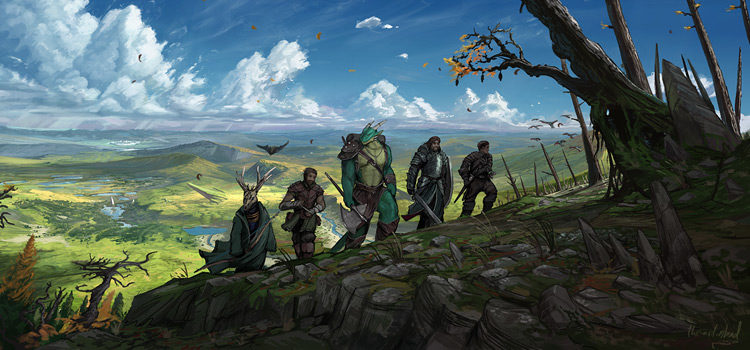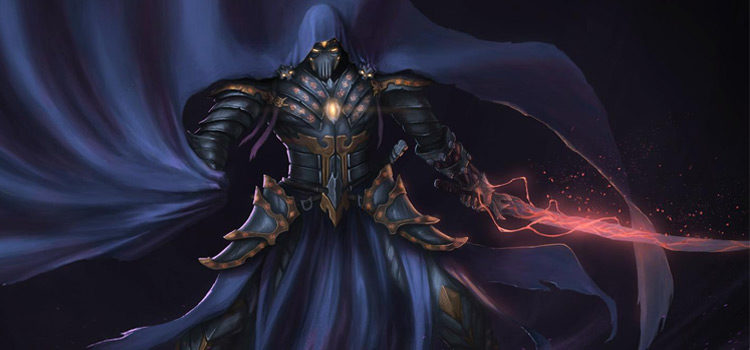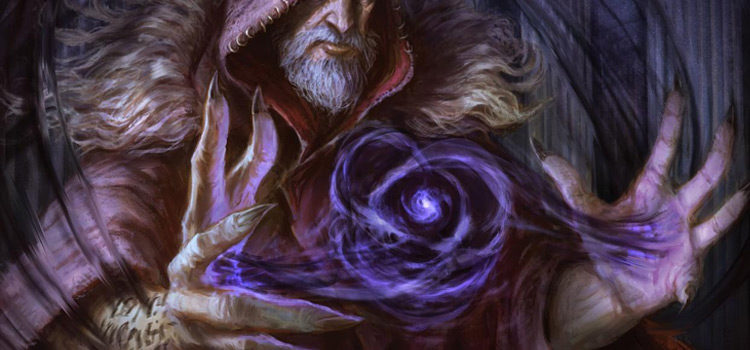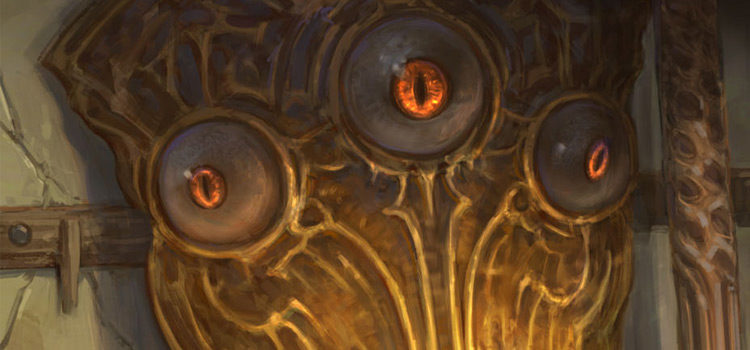True Polymorph: D&D 5e Spell Guide
This post may contain affiliate links. If you buy something we may get a small commission at no extra cost to you. (Learn more).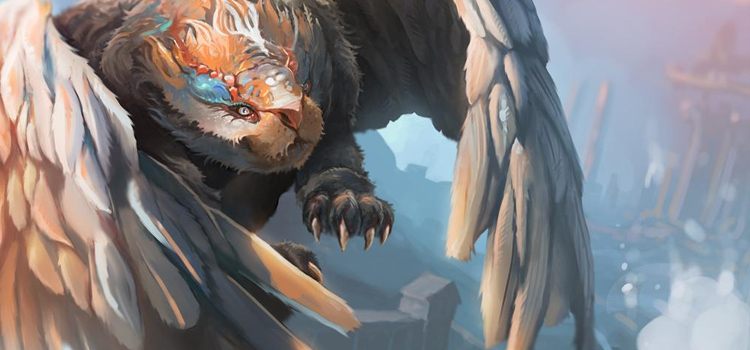
9th level spells are extremely powerful, allowing wizards and other spellcasters to effectively alter the fabric of reality.
True polymorph is one of those spells. It harkens back to the magical transformations depicted in fairy tales and ancient myths.
True Polymorph Spell Details
Type: 9th Level Transmutation
Casting Time: One Action
Range: 30 feet
Components: V, S, M (a small amount of mercury, gum arabic, and smoke)
Duration: 1 hour (Concentration)
True polymorph has so many specific details about how it works that I won’t be breaking it down entirely here. The spell is complicated enough to deserve a very careful read-through from the source (Player’s Handbook page 238).
In short, the spell can do the following:
- Turn a creature into another creature of the same Challenge Rating or lower. If the creature being transformed doesn’t have a CR (usually because they’re a player character), the new form’s CR must equal their level or lower.
- Turn an object into a creature of the same size (or smaller), and of CR 9 or lower. The creature is friendly to you. If you make the spell permanent (see below), you no longer control the creature.
- Turn a creature into a nonmagical object of the same size or smaller.
- If you concentrate on the spell for the full hour duration, the spell lasts until it is dispelled, or until it drops to 0 hit points or dies.
Again, true polymorph is a complicated spell. And if you’re planning on doing any of the above, it makes sense to go through all the specifics for each effect.
The spell doesn’t work on shapechangers, or creatures with 0 hit points. The 0 hit points rider is complicated, and you can find more detail about that below.
Entertainingly enough, the shapechanger rule is inconsistent.
The more recent mass polymorph spell specifies that it has no effect on unwilling shapechangers. Meanwhile, polymorph and true polymorph simply don’t work on shapechangers at all, willing or not.
Who Gets It?
This is of the clearer part of the spell.
True polymorph is on the bard, warlock, and wizard spell lists. Arcana Domain clerics can pick it up through their Arcane Mastery feature.
Regrettably, it also happens to be the one polymorph spell not on the sorcerer spell list.
Sorcerers can’t learn shapechange either.
That means that your dragon-souled sorcerer can’t ever actually transform themselves into a dragon, your divine soul sorc can’t ever turn into an angel, and your fey sorcerer can’t ever cast a spell to turn into a fey.
While sad, it’s not surprising. Sorcerers are the child 5e loves least.
True Polymorph: General Uses
The spell clearly outlines the three main things it can be used for: making a creature a different creature, making an object into a creature, or making a creature an object.
How to use that in a game, however, depends on your table.
Combat uses for true polymorph are split between offensive or defensive uses. On the one hand, you can try to turn a big, powerful enemy into a book or other small object, ending the fight.
However, creatures dangerous enough to warrant the use of the 9th level spell will almost always have Legendary Resistances.
You’d have to burn through those before trying the spell.
They also usually have pretty good saves, so there’s no guarantee it would work anyway.
On the other hand, the spell can be used to buff a weakened character. While it can’t be used to bring a character back from 0 hit points, you can turn another caster who is out of spell slots into a powerful creature.
The same applies to other characters who find themselves low on health or out of resources.
You can also turn an object into a creature for a little while, gaining yourself a temporary companion.
Depending on how you treat the creature, it might even choose to aid you going forward, although that’s largely up to your DM.
There’s also plenty of potential uses outside of combat. You can turn people into newts when they annoy you. You could pull a Circe and turn visitors to your island into pigs.
You could decorate your castle with golden statues you’ve created from your enemies, or plan a heist where you turn one of the guards into a replacement for your stolen fantasy version of the Mona Lisa.
There are plenty of uses for the spell in regular adventures, primarily limited by how stingy you want to be with such a powerful spell slot, and how petty you are when a tax collector knocks at your character’s door.
True Polymorph’s Tricky Details
Because true polymorph is a 9th level spell and its features are so impactful, there are a lot of questions out there about how it works.
Let’s cover a few of those here.
Zero Hit Points
Search online and you’ll find plenty of people asking for clarification on what happens when a more-or-less permanently true polymorphed creature gets killed.
Wizards of the Coast went through the process of adding some extra detail to the spell in an errata, although that still doesn’t stop the questions. Mostly because of the spell’s massive scope.
According to 5e’s designers, the intent is that when the true polymorphed creature is reduced to 0 hit points or killed, it reverts to its original form. They point to the new text from the errata, that the spell has no effect on a creature with 0 hit points.
When the target’s new form (a dragon or angel or whatever) is reduced to 0 hit points, the spell stops having an effect on it, and it reverts to its true form. Any excess damage is carried over to that original true form.
As with a lot of aspects of this spell, this isn’t universally agreed on. Some DMs rule that the spell’s text means that once you concentrate on the spell for the full hour, it can only be transformed back by dispelling true polymorph.
Different DMs may rule differently on this. It’s best to ask ahead of time what their interpretation of the spell is.
Something of note: there is a difference between a creature with 0 hit points, and a dead creature. There’s a reason the spell specifies that it lasts until a creature drops to 0 hit points or dies.
At 0 hit points, a creature may simply be unconscious. Some creatures have specific features that activate at 0 hit points. For example: at 0 HP, the vampire turns into a cloud of mist and attempts to return to its resting place to heal.
For a creature true polymorphed into a vampire, this wouldn’t activate. The creature would instead revert at 0 HP to its original form.
In addition, when a creature dies, it technically stops being a ‘creature’. At that point the game considers the corpse to be an object.
In short, you can’t cast true polymorph on an unconscious creature. But nothing is stopping you from transforming a corpse.
Which leads to a whole host of questions about what happens when you cast true polymorph on the corpse. You can only turn it into a CR 9 or lower creature, but does it still have the memories of who it was?
Is it a completely different creature, or does it still have the alignment and personality of the original?
Does its soul return? Did you just create a new soul in that body?
Does it matter if the person died recently and their brain is still relatively intact?
None of these questions are answered in the spell and would be entirely up to you and your DM.
Until Dispelled
Originally, the spell said that the transformation was permanent if you concentrated on it for the full duration.
After the errata, it specifies that it lasts until dispelled. This could be done with a dispel magic spell, some other similar magical effect, or even a wish spell if it came to that.
This opens up some useful tactics if you face a creature with access to this spell. If the enemy wizard casts true polymorph (and you aren’t able to counter it), there’s nothing that prevents you from trying to dispel it later.
Especially if said wizard turned into a dragon and is now flying. Preferably about 500 feet up in the air.
A successful dispel magic, followed by someone counterspelling the wizard’s likely feather fall spell, and you might be able to pancake them.
Effects like antimagic field will suppress a true polymorphed form, but the creature will turn back once they leave the field.
Spell Concentration
There are some questions about what happens if you polymorph yourself into a creature with a low intelligence score.
Most of these questions focus on whether you can maintain concentration while in that form, or if you are smart enough to stop concentrating on it when you want to.
The official answer is yes to both questions.
That said, if it makes sense at your table for you to have a hard time ‘remembering’ to drop out of t-rex shape or some other powerful and low-intelligence form, that’s totally fine.
There’s room for a lot of light-hearted humor in the wizard being temporarily ‘stuck’ in the form, until someone talks them out of it. As long as the table is having fun, there’s no real harm in playing up a non-existent problem.
Gaining Equipment
Jeremy Crawford (the Lead Rules Designer for 5e) has given out a number of answers about equipment from polymorphed creatures, both on twitter and in official channels like the Sage Advice segments from Wizards’ streams and podcasts.
According to him, when transforming into a creature, you aren’t supposed to suddenly gain the equipment that creature normally has as a part of their statblock.
To an extent, that makes sense. They don’t want players being transformed into monsters that normally come with expensive gear (namely magic items) and then selling that for quick cash.
Granted, this is a 9th level spell. And there’s nothing to stop you from creating money in other ways.
What they don’t mention are any specifics about what ‘gear’ means in this context. Presumably, their definition of ‘gear’ extends to the greatsword that most planetars carry.
Hopefully it doesn’t extend to the clothing they’re wearing.
Clothes are listed, unfortunately, as adventuring gear in the Player’s Handbook (pg. 151). It’s all general categories (fine clothes, travelling clothes, common clothes, etc.) so you could infer that something like a scarf or the planetar’s angelic skirt-wrap doesn’t really count.
To be honest, most DMs probably won’t quibble too much about your planetar having a greatsword.
But if you take Crawford literally, the planetar you true polymorph into might look less like a stereotypical angel and more like Doctor Manhattan.
Again, this could be a source of humor at your table, if everyone there is comfortable with it. As usual, you and your fellow players will know your table best.
Polymorphing into NPCs
This argument hinges on the phrasing of “another kind of creature”. For example, could you true polymorph someone into Jarlaxle, a specific individual in the Forgotten Realms?
The general consensus is no. But some DMs might let you get away with it by turning into someone ‘like’ Jarlaxle.
Less clear-cut is the question of if you can true polymorph into an NPC statblock like the archmage.
NPCs are listed separately in the Monster Manual, and the Dungeon Master’s Guide goes into some detail about how you can take the framework of the statblock and customize it by adding unique racial traits and other abilities.
Some DMs will rule that NPCs aren’t a ‘kind’ of creature, they’re a specific creature that you can’t true polymorph into.
Taking that to its logical extent means that the same could apply to creature statblocks beyond just the NPC lists, such as a drow gunslinger, a sahuagin deep diver, or a githzerai anarch.
You’d be able to turn into a standard githzerai, drow, or sahuagin, but not the more powerful forms.
Some of those are already moot, like the gunslinger. The transformation wouldn’t give you the gun needed to gun-sling.
At this point, however, you’re forced to ask why you’d be able to choose to be an older or younger dragon, since those use different stat blocks as well.
In the end this is a decision for your DM.
I know that’s something I’m saying a lot in this guide, but because of how this spell can be read in many different ways, it’s kind of an important point.
Legendary Actions
Unlike its cousin shapechange, the true polymorph spell doesn’t mention anything about whether a creature polymorphed into a powerful creature with Legendary Actions gets to use them or not.
Which is inconvenient, because there is actually a rule for this. It’s just hidden in the Monster Manual.
In one of their errata, Wizards of the Coast added a new rule to the Monster Manual. It can be found on page 11 of copies of the Manual published after the errata was implemented.
You can also find it in the errata documents found on Wizards’ D&D website.
The rule states that creatures that assume the form of a legendary creature do not gain that legendary creature’s Legendary Actions, Lair Actions, or regional effects.
As far as I can find, there is nothing that prevents a creature polymorphed into something that has Legendary Resistances from using those.
Shenanigans: True Polymorph Ideas
To be perfectly clear, everything listed below depends on your DM’s permission for it to work.
That’s not to say these ideas don’t follow the rules. But they depend on certain interpretations of various spells and rules.
For the most part, I’ve used Jeremy Crawford and other 5e designers as my baseline for these uses of the spell. Everything here is something they’ve said you could technically do, or a logical extension of it.
The Drop
One of the most common polymorph tricks involves you turning a target into a small animal.
You then cause the creature to take a ton of damage at once, most often by dropping it off a cliff or out of the sky.
While you can still do this with true polymorph, the kinds of creatures you might want to use a 9th level spell slot on makes it more difficult.
So, let’s focus on some other entertaining uses…
Shield Guardians
One trick you can do with true polymorph is to turn a creature or object into a shield guardian. Shield guardians are large constructs normally created by spellcasters as bodyguards.
They come with a number of helpful abilities, including the ability to absorb half of the damage dealt to their master.
Shield guardians are controlled by unique amulets which aren’t too hard to make. It just takes one week and 1000 gp in components.
However, there are no game mechanics for making the shield guardian itself.
Between true polymorph and a week per amulet, you can create an army of shield guardians, potentially enough for every member of your party to have one.
At CR 7 you can turn an object into one, allowing you to turn any sufficiently large tree or rock into a magical robot defender.
To a more horrifying degree, you could turn an enemy creature into a shield guardian. Without an amulet, the guardian is incapacitated.
If you then spend a week to make an amulet, you could bind the guardian to your will. While its intelligence might be lower than it once was, and the guardian can’t speak, it would still have all its memories and its personality.
Which is a terrifying thought.
The creature would be effectively trapped inside a robot body that only moves or acts at the amulet wearer’s whim.
Some people might consider this a fitting punishment for a truly evil big bad of a campaign, in that at least it doesn’t outright kill them. It’s still pretty dark.
On the other hand, this could be the beginnings of a memorable questline.
Maybe the party runs across an abandoned shield guardian that happens to be an ancient hero polymorphed into a guardian by some evil wizard.
Living Bombs
This one depends entirely on what you happen to have access to within your game.
If you get ahold of some kind of explosive or dangerous compound, you could potentially turn that object into a creature with true polymorph.
Since that transformed creature follows your orders, you then send the insect or small bird you created to effectively kill itself near an enemy.
The polymorphed creature dies and reverts back to the object it was.
This could include sending a barrel of gunpowder as an insect to fly into a fireplace near someone you want to take out.
You could even turn food soaked with a contact or ingested poison into a tiny animal, then have it fly into a creature’s mouth to poison them.
This relies on getting ahold of an item that will really do some damage. But it makes for a fun (and dark) delivery method if you have something lying around.
Silver Dragon Steed
This trick requires a friendly paladin who has the find greater steed spell.
Find greater steed allows a paladin to summon a celestial, fey, or fiend spirit. It appears in the form of a loyal steed that serves them in battle.
The steed can communicate telepathically with its summoner. While riding it, any spell the paladin casts that targets themself also targets the mount.
Which is great. These are all cool features, and the spell does give you a variety of fun steeds, including griffons, saber-toothed tigers, and pegasi.
But let’s make it better.
A silver dragon wyrmling gets stronger as it ages and is the same CR as five of the six options for find greater steed.
That means you can cast true polymorph to turn said loyal mount into a dragon that will only get stronger over time.
It’s unlikely that your DM will let you say that your silver dragon wyrmling is 5 years and 364 days old when you transform it. It would be nice. Namely because the next day, your wyrmling would celebrate its birthday, become 6 years old, and turn into a CR 9 young silver dragon.
That said, even if you have to wait a full 5 years for your wyrmling to grow up, it’s still a pretty good mount. If you’re playing a game with plenty of downtime that could happen faster than you’d think.
The best part is that according to Crawford, replacing the steed’s statistics through the true polymorph spell doesn’t change or dispel the effect of your find greater steed spell. Your new silver dragon mount still has all those benefits.
The one downside is the 0 hit point rider. If at any point your mount drops to 0 HP in dragon form, it goes back to its original form, and you might lose all the time you spent waiting for your silver wyrmling to grow up.
On the other hand, that can be a fun way to prevent your mount from dropping quite so quickly against powerful foes.
The danger can be mitigated with feats like Mounted Combatant and items like the Saddle of the Cavalier. Your steed might still fall if it gets hit by an ancient dragon’s breath or a disintegrate spell, but at least it’s some level of protection.
Improved Warlock Familiars
This works the same as the trick above, just with a different spell.
Like find greater steed, the find familiar spell summons a celestial, fey, or fiend spirit in a relatively small form to help you as a magical servant.
According to Crawford’s ruling, the effects of the find familiar spell are still active, even after changing the creature’s form. That means effects like your telepathic contact and the ability to send the familiar into a pocket dimension still work for these new forms.
If you’re a Pact of the Chain warlock, this gives you some options.
The imp and the quasit are both CR 1. If you’ve summoned either, you could turn it into a young faerie dragon, or a brass or copper dragon wyrmling, all of which get more powerful as they age.
The faerie dragon gains more spells, and the brass and copper wyrmlings work the same as the silver wyrmling above.
Even if you have a CR 1/4 pseudodragon or sprite as your familiar, you still have options.
You could turn your familiar into a pixie. While it doesn’t grow into a more powerful form, it comes with a bunch of free innate spells.
The pixie’s DC isn’t high. But you can use it to get a free fly spell concentrated on by someone else, or get a few other magical effects. The pixie also has superior invisibility, making it a good option for scouting.
You could even turn your familiar into an apprentice wizard (assuming your DM allows you to make NPCs with true polymorph).
In the long run, that could be extremely helpful since your new familiar/apprentice might be allowed to gain class levels or take levels as a sidekick.
Train them long enough and your familiar could turn into a powerful mage themself, with their own familiar. Which they then cast true polymorph on in an unending cycle.
Improved Regular Familiars
For anyone with a familiar, you now have the option of turning it into a griffon… eventually.
Icewind Dale: Rime of the Frostmaiden introduces statistics for young griffons, going all the way down to CR 0, which is the challenge rating for most standard familiars.
After each year, the young griffon grows older and more powerful until it becomes a full-grown griffon after 3 years.
While it won’t ever be as powerful as a dragon, it’s still a pretty entertaining step up from a cat or a raven, and gives you a familiar with about as much utility as a paladin’s mount from find greater steed.
Material Components
This particular idea was put to Jeremy Crawford during a Q&A streamed live on D&D’s Twitch channel.
The concept here is that true polymorph allows you to turn a creature into a nonmagical object.
Apart from the fact that the object has to be nonmagical and the same size or smaller as the original creature, there are few restrictions on what you can make. For example, you can effectively ‘make’ money by turning a creature into a solid gold or marble statue, and then selling it to the highest bidder.
Alternatively, you can use the spell to turn a creature into one of the many relatively expensive and rare components needed for certain spells.
This includes the jeweled goblet needed for heroes’ feast, or the diamond(s) worth 25,000 gp that true resurrection requires.
Economies are weird. And there’s no way to tell what your DM would price a solid diamond the size and shape of a beholder or a zombie. But it’s definitely a start towards the number of diamonds you would need.
The question during the Q&A asked what would happen if that material component was used as part of a spell that consumed the component.
Would the diamonds vanish when the spell ended?
Would the goblet be destroyed but turn back into the original creature before the spell could actually ‘consume’ it?
According to Crawford’s answer in that Q&A, an object created by true polymorph could be used as a material component for the spell.
He treated it similarly to how the disintegrate spell used to work, or how the power word kill spell still does. The object is consumed by the spell, which ends the true polymorph spell.
In his example ruling, he said he would have the creature’s original body appear, now dead as a result of the component being consumed.
To be clear, this is a specific case ruling made by one of the game’s designers. Your DM could absolutely rule differently on this use. But it does give players a potential way to get ahold of expensive spell components.
Not only that, but it could theoretically be used to auto-kill a dangerous foe rather than trying to drop the object from an extreme height.
Homunculi
There are a number of spells that let you create a magical construct. Between simulacrum, create magen, and create homunculus, there are now even more ways to create magical servants for you to transform.
Homunculi are 0 CR creatures made with the create homunculus spell.
Like standard familiars, you could turn it into a CR 0 young griffon.
This is actually slightly less useful than the familiar transformation, as several of the homunculus’ abilities are from its statblock, rather than the spell used to create it.
Simulacrums
Simulacrums, on the other hand, can be extremely useful.
Through the simulacrum spell, you could create a copy of yourself or another creature, gaining a relatively powerful ally. However, simulacrums don’t regain any of their spent abilities.
It does, however, use most of the statistics of the creature it duplicates. That includes its CR or class levels.
As a result, you can cast true polymorph on your simulacrum rather than another member of your party. This will create a creature with a relatively high CR, and one that is (at least in some ways) no longer the simulacrum construct.
What this means is kind of up to your DM. Since it stops being a simulacrum, your new polymorphed creature will probably be able to regain hit points as normal, as well as regain its daily abilities (if any).
True Polymorph explicitly says that the creature maintains its alignment and personality. That’s great for you, since the simulacrum is friendly to you and creatures you choose, and obeys your commands and acts the way you want it to.
Since the simulacrum spell lasts until dispelled, the creature you’ve true polymorphed is still affected by that spell, so it should still follow your orders … probably.
At least if you go by Crawford’s ruling on find greater steed.
Ultimately it’s up to your DM, and it leads to a ton of questions, namely:
- Since it’s still affected by the simulacrum spell, do the spell features about hit points and expended abilities still apply?
- Is it still unable to become more powerful or learn new abilities?
- Is it still bound to follow your orders?
- Does it still count as a simulacrum? If not, can you now make another simulacrum without the now-transformed one vanishing?
- Can you then polymorph that new simulacrum and have an army of dragon servants?
Personally, I rule that the simulacrum spell is still ‘active’, so you can’t make more simulacrums without the original creature (transformed or not) disappearing.
That, however, is a decision entirely up to your DM.
Magen
Fortunately, magen are a lot simpler than simulacrum.
Magen are constructs created by the create magen spell, which can be found in Icewind Dale: Rime of the Frostmaiden.
Creating a magen requires you to decrease your hit point maximum by a number of points equal to the CR of the magen you make. Currently existing magen range from CR 1 to 3.
The magen spell also explicitly says that magen you create obey your orders without question.
Combine a CR 2 Demos Magen with a true polymorph spell, and hopefully, you’ll have a silver dragon wyrmling that will serve you without question for all your days.
Effectively you’ll be giving up 2 hit points from your maximum and 500gp in spell components to have a dragon companion that will only get stronger.
Again, this depends on your DM. They might rule that since the magen is no longer a magen that the spell no longer affects it. Ultimately, you’ll never know unless you ask.
Other Transformations
The same trick as above can technically be applied to any creature that can be created by magic.
However, the usefulness of these shenanigans depends on the spell used.
For example: you cast finger of death to make a CR 1/4 zombie permanently under your control. If you do, you could true polymorph that zombie into a more useful pixie, but it’s up to the DM if it is still under your control.
To be honest, there’s really no way you can list every potential use of true polymorph. Because there are so many spells that could interact with it.
At the end of the day, the only thing limiting your overpowered and ridiculous ideas is what your DM will let you get away with.
